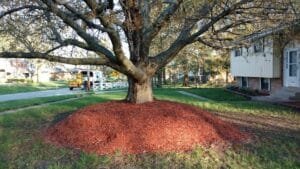Please, please . . .
stop killing your trees.
Those big mounds of mulch, all over the yard,
will stifle the roots and make life oh so hard.
I know you don’t mean it. You love trees instead.
but those big mulch volcanoes, will kill your trees dead.

Really . . . ? We’re having this conversation again? I thought we had covered this in sufficiently indignant detail last year . . . and the year before . . . and the year before that. Well, for those looking for the executive summary, here it is. Mulch volcanoes kill trees. Period!
Ok. Now for those of you interested in the deeper story, here it is.
The Problem –
Mulching your garden, indeed, mulching your young trees can be a good and noble thing. It can help to suppress weed growth, retain soil moisture for your young tree’s roots and can also help to keep wayward mower decks from damaging tree bark. But too much of a good thing is . . . well . . . too much of a good thing.
Building monstrous mounds of mulch – mulch volcanoes – around the base of a young tree creates several immediate problems. First, it creates s similar situation that the tree would encounter if it was planted too deeply. The roots end up a greater distance from open air and so don’t have access to the oxygen carbon dioxide exchange they need for healthy growth. Secondly, the big mulch volcanoes provide a nice, moist and protected place for disease organisms to live up close to the bark and can result in all kind of cankers, root and crown rots. Finally, those big, fluffy mulch volcanoes make a perfect home for bark chewing rodents. Added to those problems, mulch volcanoes can cause trees to produce roots in the mulch layer that is more prone to drying out during hot, dry stretches.
Of course we haven’t event gotten into the fact that a yard full of mulch volcanoes looks a bit like a squadron of ET’s brethren all landed in the middle of your front yard!
The Mystery –
Nobody that I’ve found out there has any idea where this practice originated. Yes, mulching can be good for your trees. But building 1 to 2-foot tall mounds of mulch around the trunks of young trees is taking a good idea way, way too far. Aside from being bad for your trees, it costs you money – either just materials (if you’re doing the volcano building yourself) or materials and labor (if you hire it out.) Hmmm . . . It costs more money and is bad for your trees. Sounds like a no-brainer to me.
The Solution –
Let’s talk about a solution using a fictitious case. Let’s say you have 10 trees in your yard and each one is surrounded by a 4-foot diameter mulch volcano 12” high. If best practice recommends 2 inches of mulch as a maximum, you already have enough mulch in your yard to last until 2028! Ok, ok . . . some of that mulch will decompose over time. So let’s say you’re good for the next 4 years. Just think, though. That’s 4 years without having to buy mulch. Four years of not having to arrange for delivery. . . Four years of better and happier tree roots. I think you get my point.
While all the above seems pretty straightforward, it leaves two questions. What do you do with existing mulch volcanoes and how do you help to abolish the practice.
Existing Mulch Volcanoes –
While it’s best to not start building volcanoes in the first place, sometimes you inherit them and have to decide what to do. If they are newly formed around your trees it’s best to remove most of the mulch now. Simply rake it off onto a tarp and drag it away somewhere you can stockpile it until you need it elsewhere. You should leave no more than a 2-inch layer on top of the existing soil.
But if the mulch volcanoes have been there for a number of years you may find that you have roots growing out of the trunk and into the mulch. In these cases you need to have a little bit of a lighter touch. Gently rake back the mulch to the required level and then carefully prune the exposed roots back to the trunk surface. You’ll have to pay a little extra attention to keeping your young tree watered through the dry season this summer but in most cases the tree should recover nicely.
Battling the Practice –
This is a tough one. Again, nobody seems to know how volcano mulching got to be such a common practice. But it has been widely shown in excellent research and reported throughout the landscape industry for decades that this practice is harmful to trees. Those in the industry should know better – if they’re paying attention at all. If they haven’t gotten the message yet, you might want to look elsewhere for professional services.
Sometimes, questionable practices like volcano mulching are perpetuated because homeowner’s associations or similar administrative units simply re-up long standing contracts without any evaluation of the service. But a simple change to the new contract – specifically identifying practices to be eliminated – make for easy solution.
This article was originally submitted to the Courier Journal on April 13, 2022.

